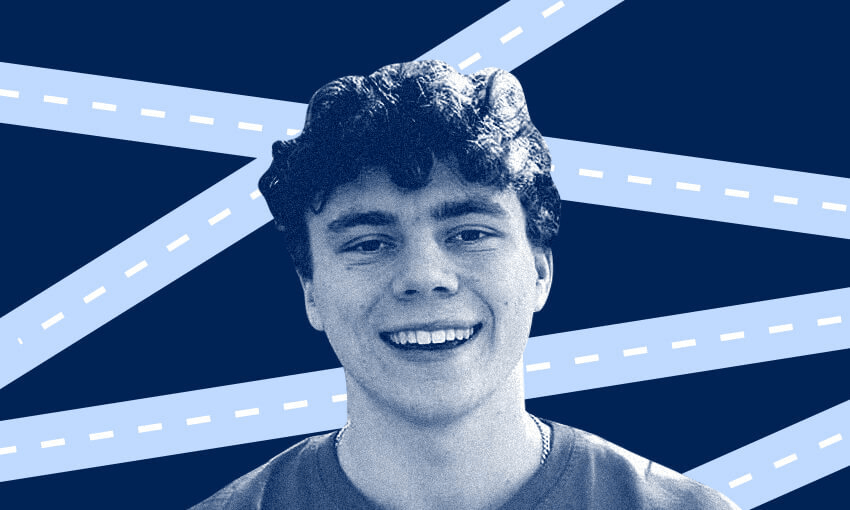After a 19-year-old was killed while riding his bike on a dangerous stretch of Auckland road, the tragedy became a rallying call to make the city safer for cyclists. Tommy de Silva looks at what’s been achieved in the 12 months since.
On March 5, 2022, 19-year-old Levi James was killed on his bike en route to visit his grandmother. This tragedy occurred near Auckland’s infamously dangerous Royal Oak roundabout on Manukau Road. Levi’s passing hit home for me. We went to the same school, and at the time of the accident, I lived in Royal Oak, often biking – scared every time – the treacherous Manukau Road stretch where Levi was hit. This area has long been designated as a strategic cycling route, but has zero bike infrastructure. Because of that, Bike Auckland chair Tony Mitchell said Levi’s death was “entirely preventable”.
Over the last year, Levi’s name has become a rallying call for everyday cyclists, bike advocates and the Auckland Transport (AT) cycling team, used as motivation for safety improvements. When I mentioned the tragedy to AT’s head of cycling, Adrian Lord, he was noticeably upset, but he assured me that progress towards safer cycling had been made since March 2022. The best way to keep people on bikes safe is separated infrastructure, which has the added benefit of making transport safer for all modes. Let’s look at AT’s cycling progress: what has been completed? What work is currently under way? And what has been planned?
I don’t know how, or when, I’m going to die. But I know it’ll be going through the Royal Oak Roundabout pic.twitter.com/dtA0KY5d23
— scoot! (@ScootFoundation) December 1, 2020
Completed projects: the big stuff
Glen Innes to Tāmaki Drive safety improvements – Te Ara Ki Uta Ki Tai
This almost finished 7km project will eventually connect Glen Innes with significant swathes of existing cycle infrastructure. AT’s Sam Stephenson told me that in May 2022, the longest section of the project was completed, “stretching 2.65 kilometres from St Johns Road to Ōrākei Basin”. Last month the works around Ōrākei were completed, and from there, an interim last link along Ngapipi Road to Tāmaki Drive is set to be finished this month – to be replaced with a permanent boardwalk in 2025. When finalised, this package will link to the existing cycling network and provide a safe east-west isthmus link – a significant achievement for Auckland’s bike infrastructure.
New Lynn to Avondale path
This 2.9km link between New Lynn and Avondale opened in June 2022 and connects two of West Auckland’s biggest town centres. The New Lynn-Avondale path also taps into existing bike networks to maximise its potential. This enhancement “creates a continuous path connecting New Lynn and Avondale and onwards to the city centre via Waterview and the northwestern path, and to the southwestern path towards Onehunga,” Stephenson said. Hopefully, this project will inspire more work westward towards the cycling safety blackhole that is Glen Eden.
Ngā Hau Māngere Bridge
This one has got to be the prettiest of the bunch – thanks, Waka Kotahi! Opened last August, this beautiful bridge crosses Te Manuka from Onehunga to Māngere Bridge. It project replaced the “Old Māngere Bridge”, which was becoming dilapidated. Once more, this improvement links to existing enhancements. On the Māngere side, it leads onto traffic-free routes toward the bikeable Ambury Regional Park (a great day trip) and, on the Onehunga end, connects to the southwestern path. Via Ngā Hau Māngere Bridge, the southwestern route connects cyclists from Māngere in the south to the CBD in the north via the Waterview and Northwestern paths.
Completed projects: the small (but no less important) stuff
Clark Street, New Lynn
This 1.3km protected infrastructure provides safe access along the main road to the New Lynn train station, and also connects to the New Lynn Bike Hub, Stephenson noted.
Grafton Road
This 450m protected cycleway outside the Auckland Hospital gets cyclists close to the existing Grafton Gully cycleway.
Ian McKinnon Drive
Linking the northwestern path and Dominion Road, this 780m upgrade improves bike safety at the start of one of our busiest roads.
Lambie Drive and Manukau Station Road
These 2.2km of protected cycle lanes create a direct and safe bike connection between the Manukau city centre and the local public transport hub.
Mission Bay
Further expanding the already great Tāmaki Drive cycle lanes, the Mission Bay improvements “built raised crossings and added a separated cycleway on Tamaki Drive through the busy Mission Bay village”, said Stephenson.
Northwestern path upgrade
This 850m improvement separates bikes from pedestrians in the Eden Terrace and Kingsland gullies. The upgrade area is along one of Auckland’s busiest cycling routes in a spot that used to be a major bike-pedestrian conflict zone.
Project Wave
Opened this January, this improvement “provides a vital traffic-free 0.8km link through the Viaduct area, connecting the existing cycle tracks on Quay St and Nelson St”, Stephenson said. It completes Auckland’s city centre bike loop.
Projects currently under way
Links to Glen Innes
AT has been championing local upgrades in Glen Innes (GI) as well as connecting the area to the existing bike network. The Taniwha Road section of this project is due to be completed next month. “The route links to Glen Innes town centre, Tamaki College and Glenbrae School and to existing greenways around Point England and towards Panmure,” Stephenson said. For Taniwha Road, separated cycleways alongside new bus stops and pedestrian crossings are in the works. Next Line Road, Apirana Avenue, Morrin Road/Stonefields Avenue and Merton Road will be enhanced. This mahi is being done alongside planned stormwater upgrades and surface renewals to minimise disruption. Added up, the “Links to GI” projects will create 7.3km of dedicated cycleways in a historically unsafe suburb.
Upper Harbour Drive
Installed in April 2022 – to mixed reviews – and now under consultation for a permanent design, this project “forms a 3km protected extension connecting to the northwestern path at Greenhithe”, said Stephenson. Eventually, the plan is to link the Upper Harbour Cycleway to existing infrastructure to form a direct route to Takapuna and Albany.
It’s clear, then, that there have been some significant cycling safety improvements since Levi James was killed on his bike last year, and as someone for whom biking is an everyday form of transport, I am super grateful. AT’s cycling team ought to be commended for their work – unfortunately, they have long been dealt a horrible hand by their organisation and some of Auckland’s leaders. Mayor after mayor, election after election, AT board after AT board, transport plans championing cycling have typically been dreamt up and promptly ignored or delayed. Hopefully, Lord’s team will be dealt the hand they deserve – a royal flush of institutional and political support – before another cyclist is killed on Auckland’s roads.

